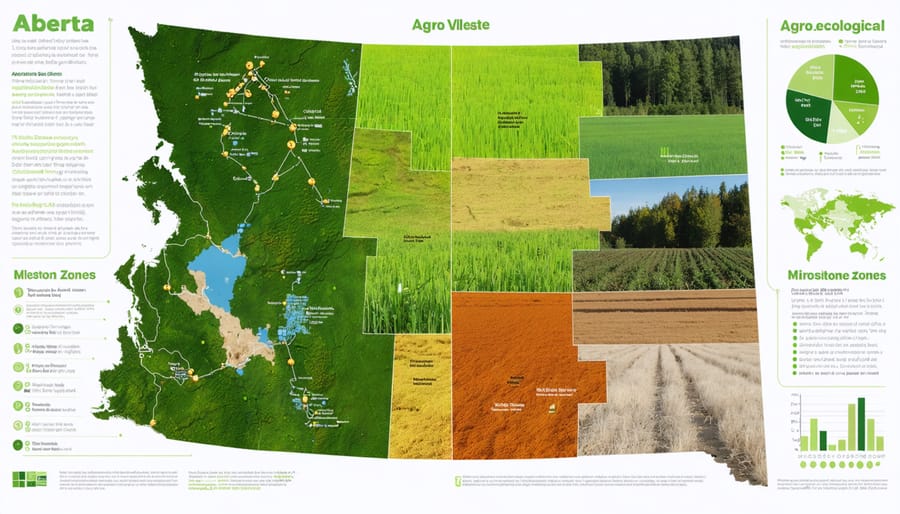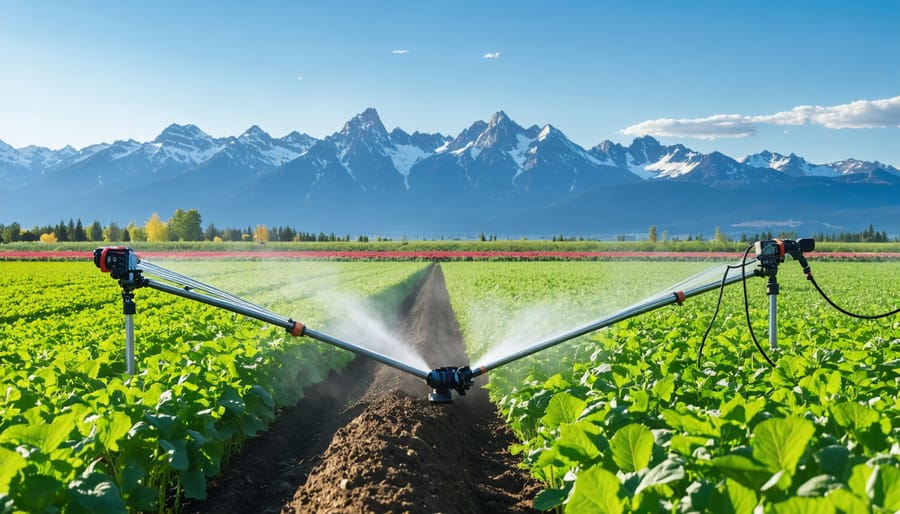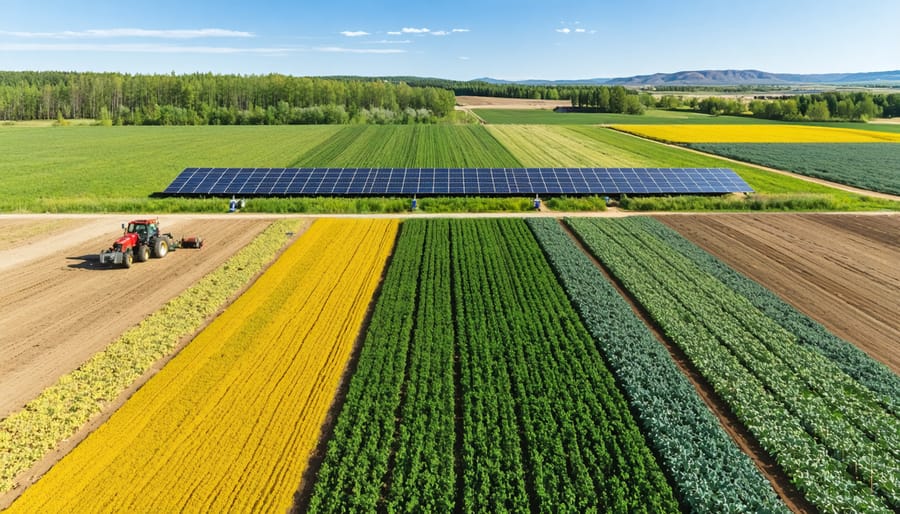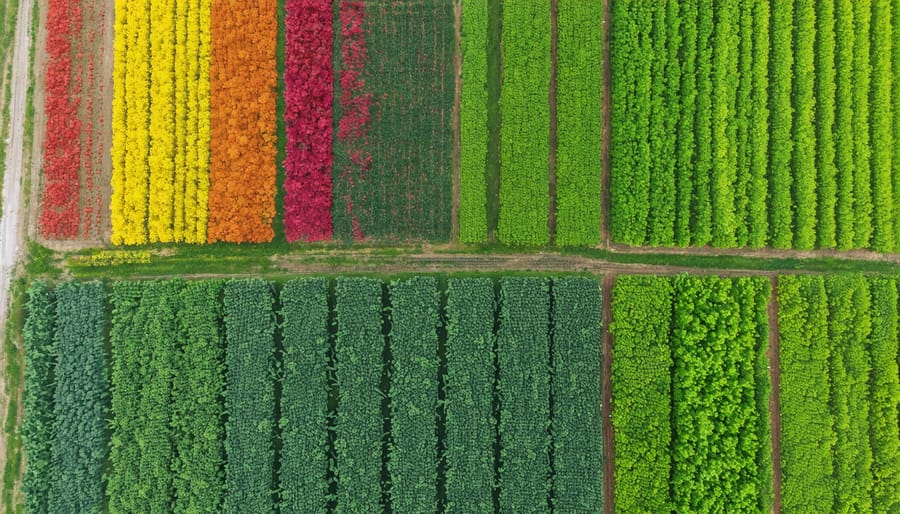Map your farm’s unique agro-ecological zones by identifying distinct soil types, moisture patterns, and microclimates across your land. Alberta’s diverse landscape demands precision in managing climate risks through targeted growing strategies for each zone. Strategic crop selection within these zones maximizes yields while protecting soil health – consider moisture retention in dry uplands, frost patterns in low-lying areas, and wind exposure on elevated terrain.
Agro-ecological zones shape every aspect of successful farming in Alberta, from seed selection to harvest timing. These natural boundaries, formed by the interaction of climate, topography, and soil conditions, create distinct growing environments that determine crop success. Understanding these zones enables farmers to adapt their practices to local conditions, building resilient agricultural systems that withstand environmental challenges while maintaining productivity.
By working within these natural boundaries rather than against them, producers across Alberta are transforming challenges into opportunities, developing sustainable farming practices that honor both tradition and innovation. This systematic approach to agricultural planning ensures optimal resource use while preserving the land’s productive capacity for future generations.
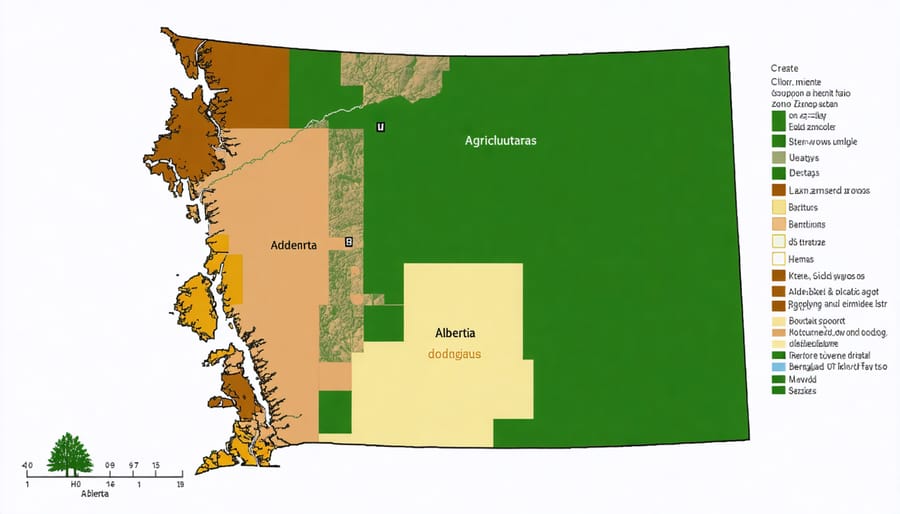
Understanding Alberta’s Distinct Agro-Ecological Zones
Prairie Region
The Prairie region represents one of Canada’s most productive agricultural zones, characterized by its vast expanses of grassland and rich, deep soils. This zone typically experiences a semi-arid to sub-humid climate, with annual precipitation ranging from 300-500mm. Summers are warm, with temperatures averaging 20-25°C, while winters can drop below -20°C.
The soil profile predominantly features Chernozemic soils, known for their high organic matter content and excellent moisture retention capabilities. These dark-colored soils support diverse farming operations, from extensive grain production to specialized crop cultivation.
Farming potential in the Prairie zone is significant, particularly for wheat, canola, barley, and pulse crops. The long daylight hours during the growing season (up to 16 hours in summer) contribute to rapid crop development. However, farmers must manage challenges like spring frost risk and periodic drought conditions.
Recent climate data shows increasing weather variability in this zone, prompting many Alberta farmers to adopt climate-smart practices. These include conservation tillage, crop rotation strategies, and precision irrigation systems. The zone’s agricultural success largely depends on effective moisture management and soil conservation techniques.
Parkland Belt
The Parkland Belt represents a vital transition zone between Alberta’s prairie and boreal regions, characterized by a mix of grasslands, aspen groves, and rich black soil. This diverse landscape typically receives 450-500mm of annual precipitation, making it ideal for both crop production and livestock operations.
Farmers in this region benefit from a longer frost-free period compared to northern zones, typically ranging from 100 to 120 days. The combination of adequate moisture and rich soil supports various agricultural activities, including canola, wheat, barley, and pulse crops. Mixed farming operations thrive here, with many producers successfully integrating cattle grazing with crop rotation systems.
The zone’s natural vegetation patterns provide excellent opportunities for sustainable agricultural practices. Shelterbelts formed by native aspen stands help reduce wind erosion and create beneficial microclimates for crops. Local producers often utilize these natural features to enhance soil conservation and wildlife habitat while maintaining productive farming operations.
Climate change resilience in the Parkland Belt is supported by its ecological diversity, though producers should monitor changing precipitation patterns and adapt their management strategies accordingly. Many successful farms in this region implement flexible rotation systems that can adjust to varying seasonal conditions.
Northern Forest Zone
The Northern Forest Zone presents unique opportunities and challenges for Alberta’s agricultural community. This region, characterized by its boreal forest ecosystem, typically experiences shorter growing seasons of 70-100 days and receives annual precipitation between 450-500mm. Farmers in this zone successfully cultivate cold-hardy crops like barley, oats, and certain forage species. The area’s rich organic soils support sustainable farming practices, though careful management is essential.
Primary limitations include frost risk, even during summer months, and the need for extensive land clearing. However, innovative farmers have adapted by implementing techniques such as shelterbelts and precision timing for seeding. The zone’s natural forest cover also provides opportunities for agroforestry initiatives, combining traditional agriculture with sustainable forestry practices.
Local success stories show that with proper soil management and crop selection, productive farming is achievable despite these challenges. Many operations have found success with mixed farming approaches, integrating livestock with crop production to maximize land use efficiency.
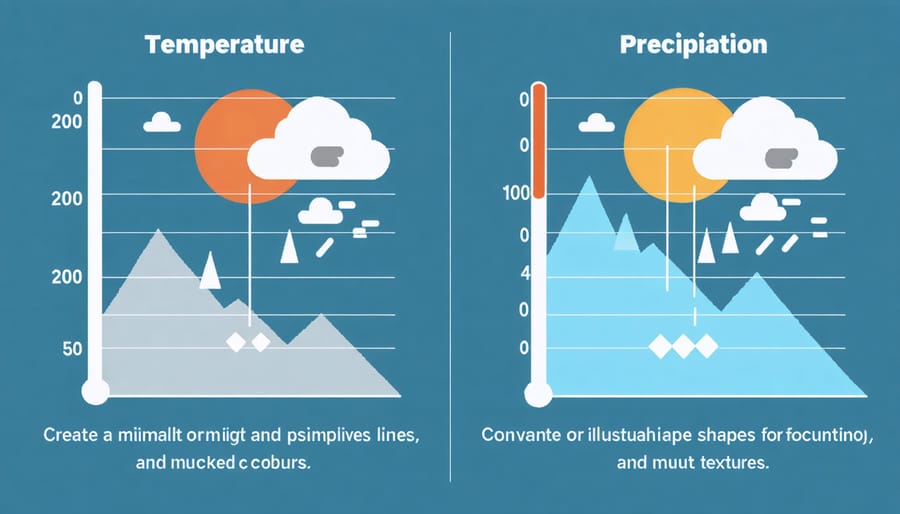
Climate Risk Factors Across Zones
Temperature Patterns and Frost Risk
Temperature patterns across Alberta’s agro-ecological zones significantly influence crop selection and growing seasons. In the Peace Region, farmers typically experience shorter frost-free periods of 90-110 days, while southern zones enjoy extended growing seasons of up to 130 days. These variations create distinct opportunities and challenges for agricultural planning.
Local farmers have developed effective frost management strategies, including the use of shelterbelts and careful timing of seeding operations. In the central parkland region, for example, producers often monitor overnight temperatures in May and September, using frost forecasting tools to protect sensitive crops.
Daily temperature fluctuations can vary dramatically, particularly in foothill areas where elevation changes impact local climates. Southern regions generally experience warmer growing conditions but face greater risk of heat stress during peak summer months. Northern zones, while cooler, benefit from longer daylight hours during peak growing season.
Understanding these patterns helps farmers make informed decisions about crop timing and variety selection. Many successful producers use micro-climate monitoring systems and work with local agricultural extension services to optimize their planting schedules based on zone-specific temperature trends.
Precipitation and Drought Patterns
Across Alberta’s diverse agro-ecological zones, precipitation patterns vary significantly, with annual rainfall ranging from 300mm in the southeast to over 450mm in the central parkland regions. These patterns directly influence crop selection and farming strategies throughout the growing season.
Southern Alberta typically experiences semi-arid conditions, with farmers often managing drought risks through irrigation systems. The central regions benefit from more reliable rainfall patterns, particularly during critical growing months from May to August. Northern zones generally receive higher precipitation levels but face challenges with shorter growing seasons.
Local farmers have developed effective strategies for monitoring and responding to drought conditions. Many use soil moisture probes and weather monitoring systems to track precipitation levels and plan irrigation schedules accordingly. The Alberta Agriculture and Forestry department provides regular drought outlook reports, helping farmers make informed decisions about crop timing and water management.
Recent climate trends show increasing variability in precipitation patterns, making it essential for farmers to implement adaptive management strategies. These include selecting drought-resistant crop varieties, maintaining soil organic matter, and implementing moisture conservation practices like reduced tillage.
Extreme Weather Events
Alberta’s agricultural zones face increasingly challenging extreme weather patterns, from severe thunderstorms in the south to prolonged dry spells in the central regions. Each zone requires specific preparation strategies to protect crops and livestock.
In the Peace Region, farmers contend with early frosts and heavy spring rains, making crop timing crucial. Successful producers use weather monitoring systems and maintain flexible planting schedules. The Parkland zone experiences intense summer storms, requiring robust drainage systems and wind-resistant crop varieties.
Southern regions face heightened drought risks and occasional hailstorms. Local producers have found success with drought-resistant crop varieties and innovative irrigation methods. Many have installed hail netting over high-value crops and implemented soil moisture conservation practices.
Preparation strategies include maintaining emergency feed reserves, installing weather stations, and developing strong community networks for resource sharing during extreme events. Regular soil testing and adjusting planting dates based on long-term weather forecasts have proven effective across all zones.
Zone-Specific Management Strategies
Crop Selection and Rotation
Selecting climate-appropriate crops for your specific agro-ecological zone is crucial for successful farming in Alberta. Each zone presents unique growing conditions that influence which crops will thrive and how to plan effective rotation cycles.
In the Black Soil Zone, farmers typically succeed with canola, wheat, and field peas, rotating these crops on a three to four-year cycle to maintain soil health. The Dark Brown Zone is well-suited for barley and drought-resistant wheat varieties, with pulses like lentils working well in rotation schedules.
For the Brown Soil Zone, where moisture conservation is critical, consider drought-tolerant crops such as durum wheat and chickpeas. Many farmers in this region implement longer rotation cycles of 4-5 years to manage soil moisture effectively.
Remember to factor in your local frost-free period when selecting crops. Northern regions might benefit from early-maturing varieties, while southern areas can accommodate longer-season crops. Consider incorporating cover crops like clover or rye between main crop cycles to improve soil structure and nutrient content.
Local success stories show that adaptive management and careful crop selection can lead to sustainable yields even in challenging conditions. Connect with your regional agricultural extension office for specific variety recommendations tailored to your zone’s conditions.
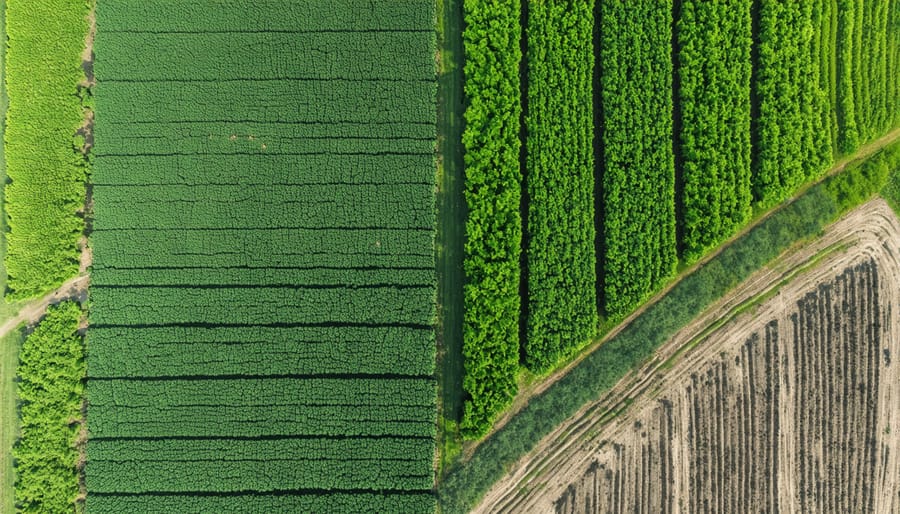
Soil Management Practices
Effective soil management is crucial for maintaining productivity across Alberta’s diverse agro-ecological zones. Each zone requires specific soil conservation techniques tailored to local conditions and challenges.
In the Brown and Dark Brown soil zones, where moisture conservation is critical, reduced tillage practices and crop residue management help prevent wind erosion and maintain soil organic matter. Many successful farmers in Southern Alberta implement strip cropping and maintain permanent cover crops to protect topsoil during dry periods.
The Black soil zone benefits from practices that focus on nutrient cycling and organic matter preservation. Local farmers have found success with rotation grazing and the integration of legumes into crop rotations. Regular soil testing helps maintain optimal pH levels and nutrient balance.
For the Grey Wooded zones, addressing soil acidity and improving organic matter content are priorities. Successful strategies include applying lime when necessary and incorporating green manure crops. Some innovative farmers in the Peace River region have reported significant improvements in soil structure through the use of cover crop cocktails.
Across all zones, maintaining proper drainage, implementing contour farming on sloped terrain, and using appropriate equipment timing are essential practices. Many Alberta farmers are also adopting precision agriculture technologies to optimize fertilizer application and reduce soil compaction.
Remember to adjust these practices based on your specific location, soil type, and seasonal conditions. Working with local agricultural extension services can help fine-tune your soil management approach for maximum effectiveness.
Water Management Solutions
Water management is critical for successful farming across Alberta’s diverse agro-ecological zones, with each region requiring tailored approaches to irrigation and conservation. In southern Alberta’s semi-arid regions, efficient drip irrigation systems have shown water savings of up to 30% compared to traditional sprinkler methods, while maintaining crop yields.
Many Alberta farmers are now implementing precision irrigation scheduling based on soil moisture monitoring and weather forecasting. For example, the Lethbridge region has seen successful adoption of soil moisture sensors that provide real-time data through smartphone apps, allowing farmers to make informed decisions about when and how much to irrigate.
Conservation techniques like mulching and reduced tillage help retain soil moisture across all zones. In the Peace River region, farmers using these methods report requiring 20% less irrigation water while maintaining productive crops. The installation of retention ponds and dugouts has become increasingly important, particularly in central Alberta, where they serve as reliable water sources during dry periods.
For areas prone to excess moisture, such as parts of central Alberta’s black soil zone, subsurface drainage systems have proven effective. These systems help manage water tables while preventing soil erosion and nutrient leaching. Local agricultural extension services offer guidance on designing and implementing these drainage solutions.
Water-efficient crop selection is another crucial strategy. Drought-resistant varieties of wheat, barley, and pulses are well-suited to drier zones, while faster-maturing varieties help manage water use in regions with shorter growing seasons. Many farmers are also incorporating cover crops to improve soil water retention and reduce evaporation losses.
Remember to regularly maintain and upgrade irrigation infrastructure to prevent water waste through leaks or inefficient distribution. Provincial water management programs offer support for implementing these improvements through cost-sharing initiatives.
Understanding and adapting to your farm’s agro-ecological zone is crucial for sustainable and profitable agriculture in Alberta. By recognizing the unique characteristics of your zone, you can make informed decisions that optimize crop selection, resource management, and risk mitigation strategies.
Take time to assess your specific location’s soil types, climate patterns, and growing season length. Consider implementing soil testing programs and weather monitoring systems to gather data specific to your farm. This information will help you make evidence-based decisions about crop rotation, irrigation needs, and pest management approaches.
Connect with local agricultural extension services and join farmer networks in your zone to share experiences and best practices. The collective knowledge of your farming community is an invaluable resource for navigating zone-specific challenges and opportunities.
Start small when implementing new practices suited to your zone. Consider setting aside a test plot to experiment with different crop varieties or management techniques before scaling up. Document your results and adjust your strategies based on what works best in your specific context.
Remember that successful farming in Alberta means working with nature, not against it. By aligning your agricultural practices with your zone’s natural characteristics, you can build resilience while reducing input costs and environmental impact.
Moving forward, stay informed about climate trends and emerging agricultural technologies relevant to your zone. Participate in workshops and training sessions offered by agricultural organizations to keep your knowledge current and your operation competitive.
Your role as a steward of the land is vital to Alberta’s agricultural future. By understanding and working within your agro-ecological zone, you’re contributing to both the sustainability of your farm and the strength of our provincial farming community.

